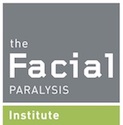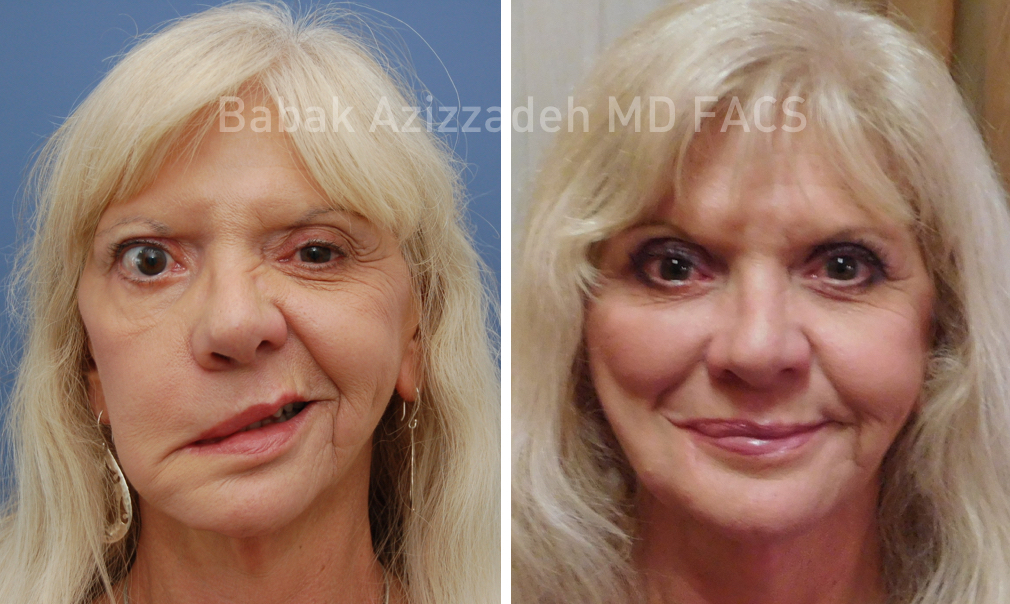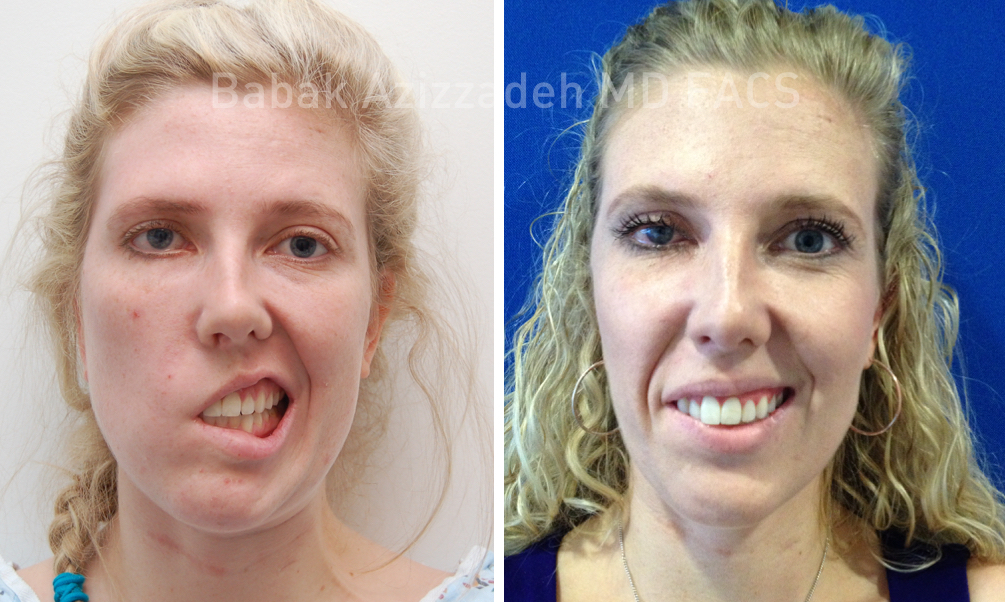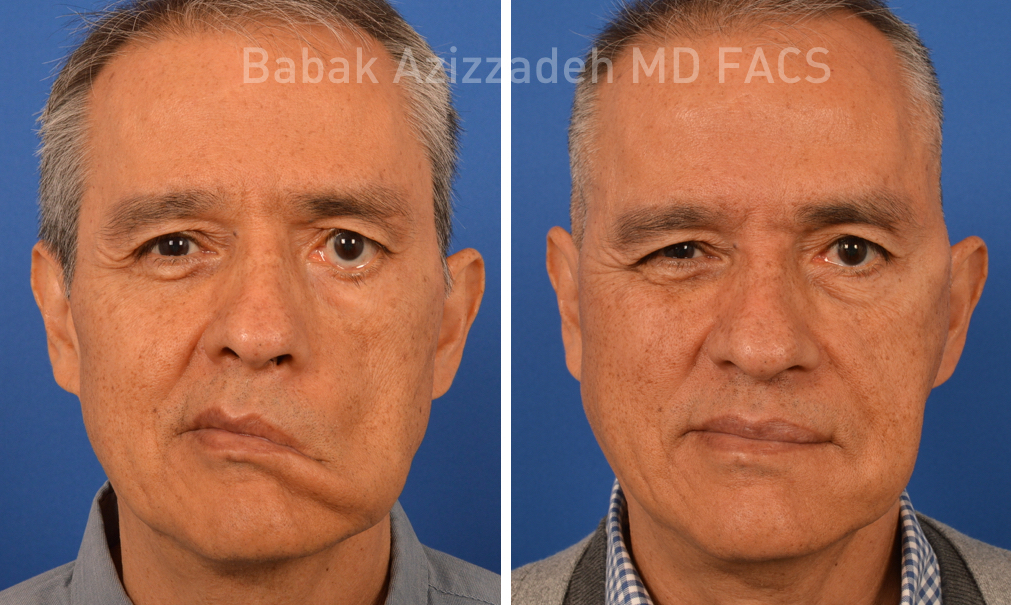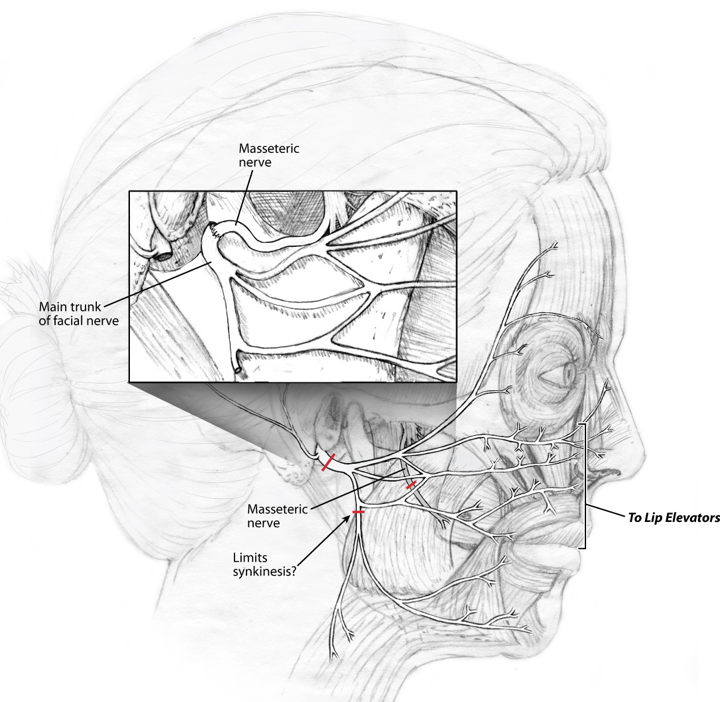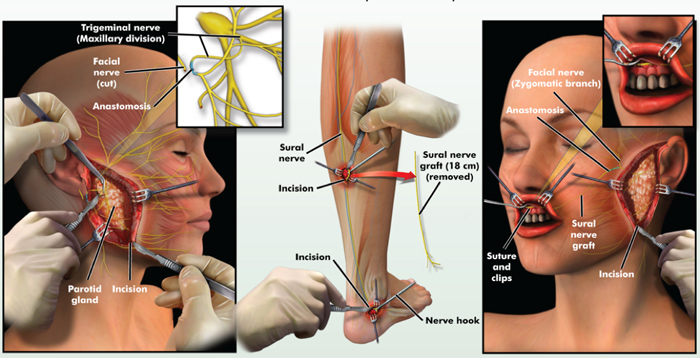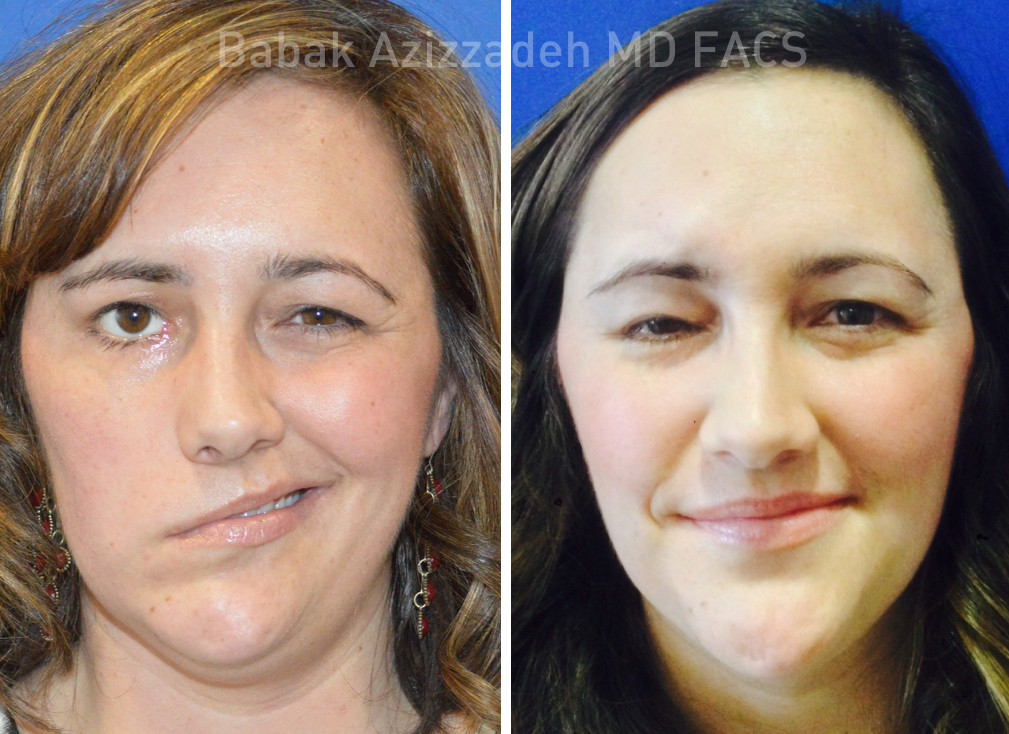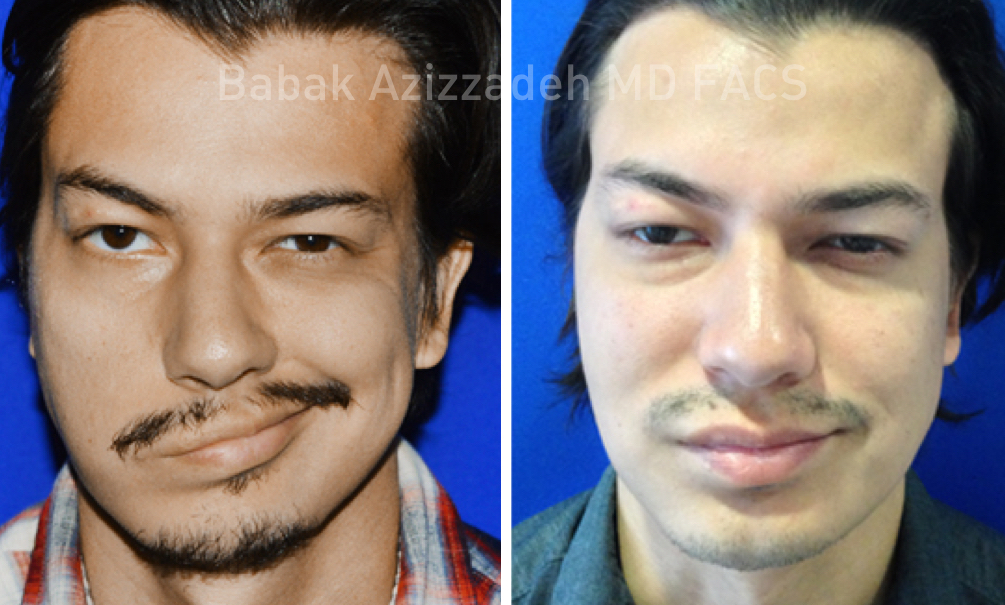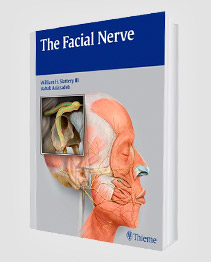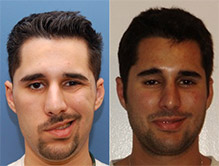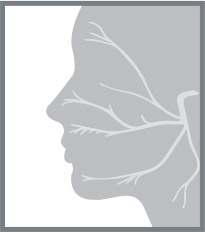The Facial Paralysis Institute is home to the most cutting-edge treatments and surgical procedures available for those suffering from Bell’s palsy and facial paralysis, including the masseter to facial nerve transfer technique.
Various medical issues such as acoustic neuromas, Bell’s palsy, trauma, parotid tumors, and Moebius syndrome can cause facial paralysis. Depending on the severity and longevity of the patient’s facial paralysis, there are multiple options a person has for undergoing surgery to regain facial animation. After evaluating a patient’s facial movement capabilities, Babak Azizzadeh, MD, FACS, expert facial paralysis surgeon, may determine the masseteric nerve transfer, also known as the trigeminal-facial nerve transfer or 5-7 nerve transfer, is the best treatment option.
Facial paralysis patients travel from across the world to have the masseter to facial nerve transfer procedure performed at the Facial Paralysis Institute in Beverly Hills. With Dr. Azizzadeh, patients are in the hands of one of the pioneers of surgical modification that leaves them with more dynamic smile and a more improved smile.
Understanding The Masseter to Facial Nerve Transfer
The masseteric nerve transfer (or trigeminal nerve transfer) has the ability to greatly improve facial reanimation for sufferers of permanent Bell’s palsy or complete facial paralysis. At the Facial Paralysis Institute, this procedure has had tremendous success in helping patients who have been experiencing paralysis for less than three years, though it is not limited to that specific longevity and greatly depends on the etiology and muscle activity.
What Are the Benefits of a Masseter to Facial Nerve Transfer?
A masseteric nerve transfer promotes facial reanimation. It can help improve the smile function in patients previously diagnosed with facial palsy. Moreover, a masseter nerve transfer can help these patients improve facial symmetry.
What to Expect During a Masseter to Facial Nerve Transfer Procedure
A masseteric-facial nerve transfer usually requires about four hours or longer to complete. During the masseter to facial nerve transfer, Dr. Azizzadeh makes an incision near the front of the ear. The facial nerve transfer and masseteric nerve are identified and sewn together under microscopic magnification. The masseteric nerve, which is used to activate chewing muscles, provides neural input into the paralyzed facial nerve, thereby restoring the facial muscle function and smile.
Once the masseter and facial nerves are connected, the nerve regeneration process begins. Masseter nerve fibers move toward the damaged facial nerve, and ultimately, help stimulate the muscles that control facial expressions.
Dr. Azizzadeh explains the masseter to facial nerve transfer procedure to a patient before treatment. He helps a masseter nerve transfer patient establish realistic treatment goals. Additionally, Dr. Azizzadeh prepares a masseter nerve transfer patient for the recovery cycle.
What to Expect Following a Masseteric Nerve Transfer
Patients typically need to avoid applying pressure to the affected cheek in the days and weeks after a masseter to facial nerve transfer. Also, masseter nerve transfer patients should avoid heavy lifting and strenuous brushing of the teeth for the first few weeks after surgery.
A patient may need to maintain a soft diet for the initial two weeks after a masseter nerve transfer. He or she may be asked to perform various facial exercises, too.
Watch Masseteric-Facial Nerve Transfer Videos
Recovery After Masseteric Nerve Transfer
Masseteric-facial nerve transfer surgery (or trigeminal facial nerve transfer), is generally performed in an out-patient surgery center and the patient is able to go home the same day.
Swelling and bruising may occur immediately after a masseteric-facial never transfer, but these symptoms typically disappear within about one week of treatment.
Patients can eat a regular diet beginning the day after a masseteric-facial nerve transfer, with a 7-10 day recovery period. During the postoperative period, patients are asked to avoid:
- Pressure to the affected cheek
- Exercise
- Heavy lifting
- Vigorous brushing of the teeth
Motion resembling the unaffected side, meanwhile, often develops between the sixth and seventh post-operative months of masseteric nerve transfer. Older individuals may require longer periods of time to achieve the desired function, but the end result is usually comparable to younger individuals.
The results of a masseter nerve transfer can be seen over the course of several months following the procedure. Yet, the recovery process for a masseter nerve transfer varies based on the patient and severity of their facial paralysis symptoms. Fortunately, Dr. Azizzadeh works closely with a masseter nerve transfer patient throughout the recovery process.
Dr. Azizzadeh stays in touch with a patient and tracks their masseteric nerve transfer treatment results. He requests follow-up appointments to ensure a patient’s recovery remains on course. Plus, Dr. Azizzadeh can respond to a patient’s concerns or questions at any point during the masseter nerve transfer recovery period.
The strength and control over the reconstructed smile will continue to improve over several years. While biting down will initially be required to produce a smile, the brain has the potential to undergo a re-education process (cerebral adaption), resulting in the production of a naturally occurring and effortless smile over time. In addition to the potential for re-education, the masseteric nerve transfer, perfected by Dr. Azizzadeh, has several extra advantages over other nerve donors. The nerve has a high density of motor axons and the ability to produce a strong smile with the proper orientation. The permanent difficulties with speech and swallowing associated with more traditional nerve transfers are also avoided utilizing this technique.
Learn more about the healing process and the need for facial physical therapy exercises following masseteric-facial nerve transfer from expert occupational therapist, Jackie Diels.
Before & After Masseteric Nerve Transfer
A masseter nerve transfer is a complex procedure, and Dr. Azizzadeh dedicates time and resources to ensure each patient can achieve the optimal results. Now, let’s take a look at before and after photos of some of the patients who have benefited from masseter to facial nerve transfer surgeries performed by Dr. Azizzadeh.
Nerve to Masseter Facial Reanimation Surgery Risks
Risks associated with a masseter to facial nerve transfer include:
- Bleeding
- Infection
- Anesthesia complications
- Excessive scarring
Dr. Azizzadeh recommends a masseteric nerve transfer procedure if he believes the procedure can benefit a patient without putting their health in danger. If the potential risks of a masseter to facial nerve transfer outweigh the procedure’s benefits, Dr. Azizzadeh will recommend other treatments.
Is a Masseter Muscle Transfer for Facial Palsy Safe and Effective?
In terms of safety, Dr. Azizzadeh takes precautions to minimize risk during a trigeminal-facial nerve transfer. Dr. Azizzadeh prepares a patient for a masseter to facial nerve transfer and ensures the patient feels comfortable with the procedure. Also, Dr. Azizzadeh carefully performs a masseter nerve transfer and works closely with the patient to maximize treatment results.
The effectiveness of a masseteric nerve transfer depends on the patient. If masseter nerve transfer patients follow Dr. Azizzadeh’s post-treatment instructions and perform facial exercises as requested, they can boost the likelihood of achieving the full results of treatment.
Who Is a Good Candidate for a Masseter to Facial Nerve Transfer?
Facial paralysis patients who previously received treatment but find that their symptoms are still present or have become worse may benefit from a masseter nerve transfer. However, facial paralysis patients who have experienced symptoms for more than two years may be ineligible for treatment.
Following two years of facial paralysis, the masseteric nerve may shut down. If this happens, the masseteric nerve cannot be used to help a patient correct facial paralysis symptoms.
Along with facial paralysis patients who have experienced symptoms for longer than two years, patients who are coping with partial facial paralysis may not qualify for masseteric never transfer treatment. For these patients, other surgeries can be used to treat a partial or weak smile.
A consultation with Dr. Azizzadeh provides a great starting point for a facial paralysis patient who is considering a masseter to facial nerve transfer. The consultation allows the patient to receive an in-depth evaluation and gain insights into a masseter to facial nerve transfer and other treatment options.
Is a Masseteric-Facial Nerve Transfer Right for You?
Much in the same way that all facial paralysis patients are different, there is no surefire solution to treat all of these patients, at all times. Therefore, it is important to set up a consultation with Dr. Azizzadeh, a world-renowned facial plastic and reconstructive surgeon regarding masseteric nerve transfer. By consulting with Dr. Azizzadeh, a facial paralysis patient can receive expert treatment recommendations and find out if he or she qualifies for a masseteric-facial nerve transfer.
During a consultation, Dr. Azizzadeh meets a facial paralysis patient and performs a comprehensive evaluation. He learns about the severity of this patient’s facial paralysis symptoms and reviews their medical history.
If Dr. Azizzadeh believes a masseter to facial nerve transfer can help a patient alleviate their facial paralysis symptoms, he will craft a custom masseteric-facial nerve transfer treatment program for this individual. Or, if a facial paralysis patient does not qualify for a masseteric nerve transfer, Dr. Azizzadeh offers treatment alternatives.
Dr. Azizzadeh strives to help a facial paralysis patient achieve long-lasting treatment results. He works directly with a patient and personalizes a facial paralysis treatment based on an individual’s symptoms. This approach has helped Dr. Azizzadeh deliver safe, effective treatment results to facial paralysis patients.
Speak with Dr. Azizzadeh About Your Treatment Options Today
If you or a loved one is suffering from facial paralysis or long term Bell’s palsy and would like to learn more about the best options for facial reanimation and facial paralysis treatment, including masseter to facial nerve transfer and cross facial nerve graft procedures, Dr. Azizzadeh encourages you to contact The Facial Paralysis Institute online or call (310) 657-2203.
Request your consultation with Dr. Azizzadeh today
Call us at (310) 657-2203 to schedule an appointment.
Schedule a Consultation